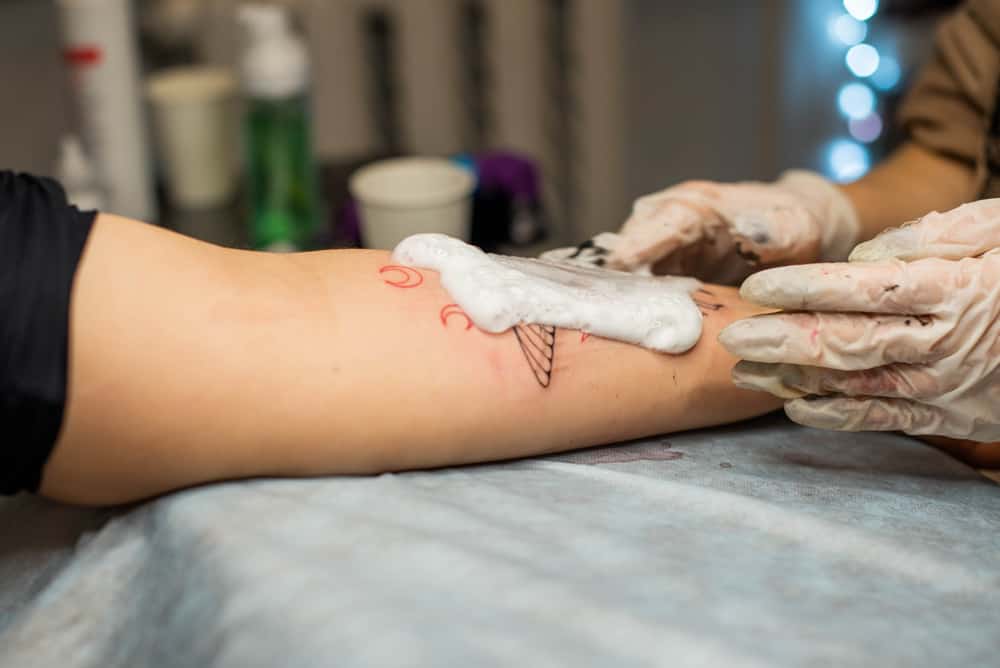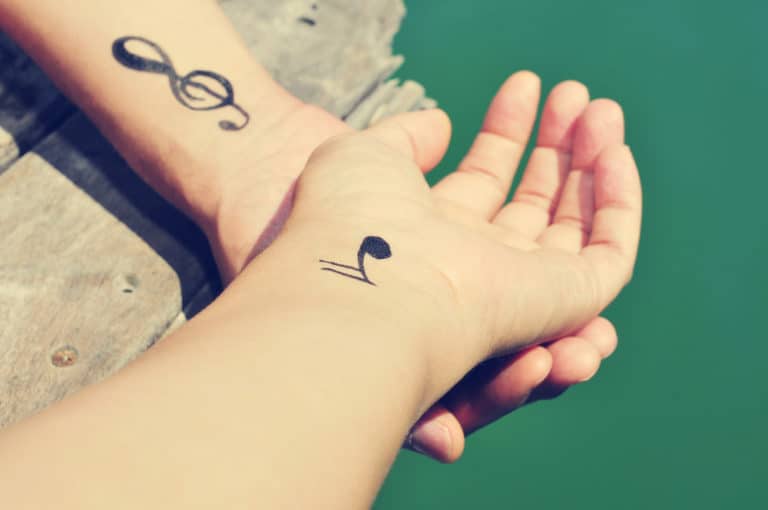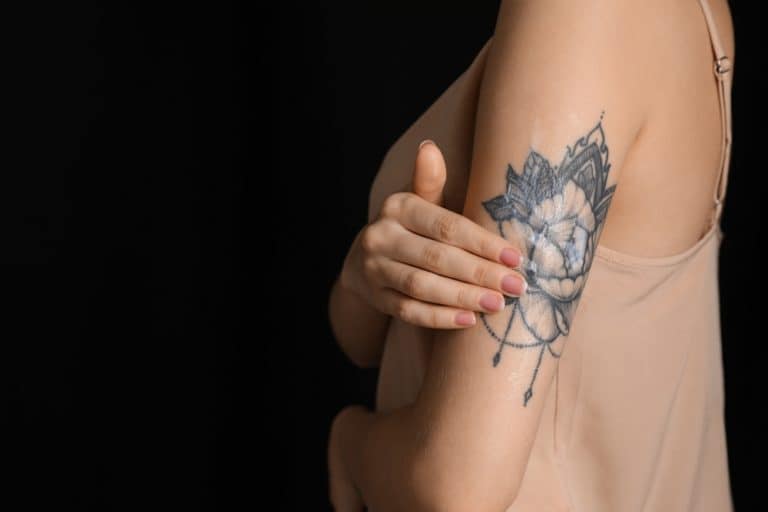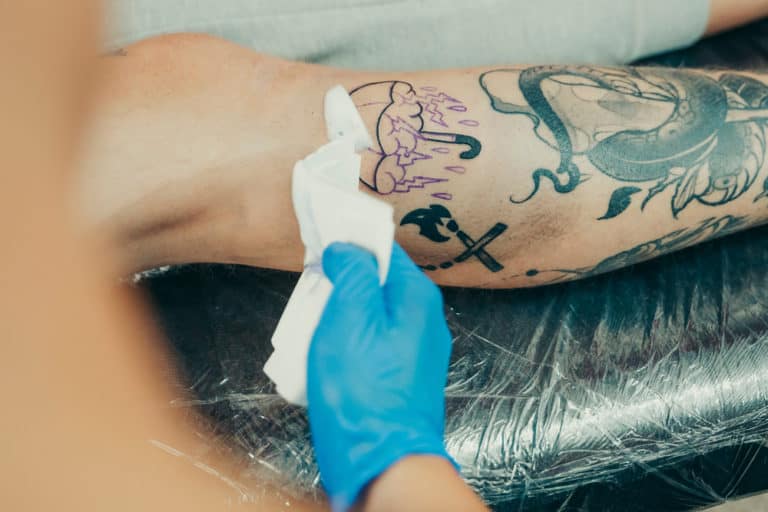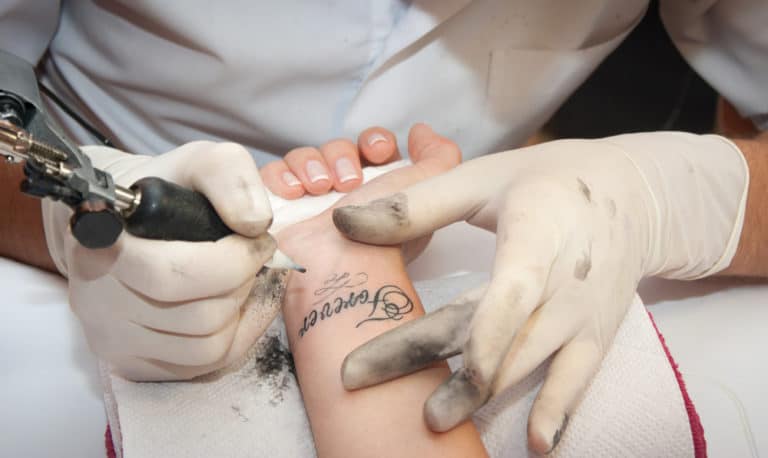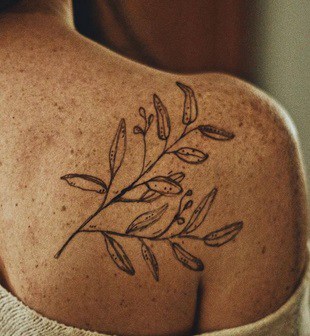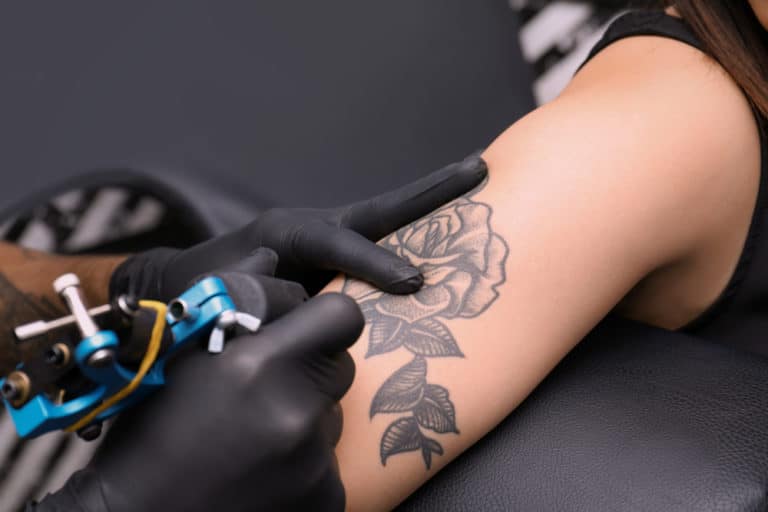How Often Should You Wash A Tattoo?
Getting a tattoo can be both thrilling and fearful, but the aftercare process can be unclear. My first tattoo involved instruction from my tattoo artist, research, and friends or colleagues I didn’t know were experts. Tattoo hygiene is vital, so how often should you wash your tattoo?
Wash your tattoo a minimum of three times a day, the third time before bedtime, when you cover it with plastic cling wrap. Clean your tattoo once every two to three days when you cover it with tattoo film wrap unless there is a lot of liquid buildup around the tattooed area.
Once you have a good grasp on your aftercare routine, you’ll find tattoo aftercare is much less stressful. Let’s explore why you need to wash it at certain times, how different wraps affect it, and some of the best ointments for cleaning your tattoo.
How Often Should You Wash Your Tattoo?
Tattoos are kinda permanent, so it’s a good idea to keep it looking good so you can keep feeling great. There are some nasty implications when you don’t use the proper aftercare routine, such as foul stench, infection, and diminishing your tattoo quality. Nobody wants that, so do you wash it at least three times a day, once every few days, or do what your tattoo artist says?
Unless your tattoo artist instructs you otherwise, wash your tattoo at least three times a day, the third time being before bedtime if you have plastic cling wrap. However, with tattoo film, you only need to wash it once every 2 – 3 days, sometimes even later, unless there’s a lot of fluid around the tattoo area. Otherwise, the wisest option is to listen to your tattoo artist.
Apart from giving tattoos, tattoo artists most likely have a ton of tattoos themselves. They know about the healing process, so listening to your tattoo artist is the wisest option, especially for your first time. While it’s true that not every artist will recommend the same aftercare procedure, they more than likely have a reason why they recommend specific details.
People who have multiple tattoos can reminisce on each one – the history, backstory, reasoning, and of course, the pain. A rib tattoo is considerably more painful than an arm tattoo because those two body areas have different amounts of skin thickness, muscles, nerves, and bones. So, it would also make sense that they need different times to heal, too, right?
A tattoo artist will know these things, meaning you can accept their advice with confidence and assurance.
Different Tattoo Wraps And What To Expect
There are several tattoo wraps available today, and each one comes with unique properties that alter the aftercare and healing process.
Cling Wraps
If you have a plastic cling wrap around your tattoo, do not keep it on for longer than 3 – 4 hours. It would be best to wash it three times a day using antibacterial soap. Sincecling wrap is not very porous, the skin creates a lot of moisture that makes a breeding ground for bacteria. In other words, tattoos need oxygen to heal.
Once you remove the cling wrap, gently clean the skin and apply the moisturizing formula. Afterward, re-apply a fresh cling wrap and repeat the process three times a day, the third time being before bedtime. Remove it again in the morning and give it another clean and moisturize before applying a fresh cling wrap.
Tattoo Film Wraps
Tattoo film wraps like Saniderm contains modern technology that gives them superior breathability and healing potential. Thus, you wash your tattoo once every 2 – 3 days or if there’s a lot of liquid buildup. In this case, you would usually leave the tattoo film on for 24 hours when you first get your tattoo before removing it and starting your aftercare routine.
The aftercare routine includes washing it with antibacterial soap, applying the moisturizer, and drying it. Afterward, re-apply the fresh tattoo film wrap. However, this time you want to leave the second layer of tattoo film on for 2 – 3 days instead of 24 hours. Three days later, you can remove the tattoo film entirely and start the healing process.
Tattoo film is excellent because it allows you more freedom without worrying about making marks on your bedsheets or white clothing.
What’s That Smell?
When you leave your wrap on for multiple days, you can expect to see a buildup of liquids consisting of blood, plasma, and ink – don’t worry, this is entirely normal. If you notice a lot of fluid around the tattoo, consider removing the film wrap and cleaning it. Otherwise, it will break down and cause an unpleasant smell. Afterward, apply a new wrap as usual.
The lower parts of the body, such as the legs, will naturally produce more liquid because it gets a lot of movement. Additionally, it’s normal to experience irritated skin near the knee area, and that’s because that area frequently rubs against the wrap.
What Does Itchy Tattoo Skin Tell You?
When something itches, our first subconscious reaction is to find relief, often in the form of a traditional scratch. However, in this case, it’s a good thing!
Itchy skin is indicative of a successful healing process. It usually follows dry, peeling, and flaky skin – but don’t be too hasty to apply moisturizing lotion, and don’t try to peel it! Allowing the skin to heal naturally will yield the best results without smothering it with unnecessary solutions.
Furthermore, it’s also normal to see bits of inked skin fall off. It’s not the tattoo coming off; scabs will form because the needle needs to catalyze the skin to start the inking process. With enough time, the skin will heal completely and be free of any previous flakiness or other abnormalities.
Why Does It Look Like Your Tattoo Is Cracking?
It may look like your painful session at the tattoo artist is unraveling, but cracking is a normal part of the healing process. It’s crucial, however, that you resist the urge to interact with it in any way – don’t touch, rub, or peel it.
Biologically speaking, cracking is indicative of the body getting rid of dead skin. This process must happen naturally, and interfering with it will only slow the healing process and prolong the cracking and itchiness. Furthermore, peeling the skin yourself may also cause the ink underneath to fade.
On the other hand, tattoo cracking can also mean your skin is dehydrated. Are you applying moisturizer as frequently as you should?
When skin becomes too dry, it can produce thick scabs that are susceptible to breaking open in multiple spots around the tattooed area. Consequently, it increases the risk of infection, scarring, and bleeding.
What’s The Best Moisturizer For Your Tattoo?
When completely dry, it’s time to apply the healing ointment. Unless your tattoo artist recommends something else, consider using Aquaphor or A&D ointment. They come with an abundance of vitamins that nourish and protect the skin and speed up the healing process. You can find them among the moisturizers near the Vaseline aisle with other rash ointments.
Do yourself a favor and avoid regular body lotions because they won’t be as effective as Aquaphor or A&D ointment. Plus, many body lotions contain alcohol that dries the skin and impede the healing process – even those claiming to “heal dry & damaged skin.”
Aquaphor is a petroleum-based compound akin to Vaseline, but they are also pretty different. It works very well and is not interchangeable with other more affordable products. Even though it’s more expensive than other options, don’t skimp on your tattoo quality and get some Aquaphor.
If you don’t have access to Aquaphor or A&D ointment, your next best bet is to get advice from your tattoo artist. Once your tattoo is far into the healing process, you can switch to something more affordable containing coconut oil and vitamin E.
Should You Change Your Wrap Before Bedtime?
On the day you receive your tattoo, your skin will be more susceptible to friction, bacteria, infection, and you will most likely experience some bleeding. Thus, tattoo artists suggest going to bed with a clean wrap for the first night and the next two days afterward. It will prevent your tattoo from rubbing against the sheets, plus the sheets will be free from bloody stains.
Unless you have a Saniderm wrap or your tattoo artist states otherwise, you should remove your wrap, clean your tattoo, and apply a fresh wrap before bed. Here’s what you need to do:
- Wash your hands. It is vital to realize that a tattoo is equivalent to an open wound, which means it is very prone to infection.
- Slowly remove the current wrap.
- Use your hand, applying antibacterial soap and lukewarm water to clean your tattoo. Use a circular motion, ensuring that you clean the entire tattoo area.
- Gently pat it dry with an old t-shirt or a paper towel. Avoid bath towels because they are often too abrasive.
- Moisturize the skin with the ointment your artist recommends, or you can use A&D ointment. Get a cream for each tattoo – you don’t want to cross-contaminate any tattoos.
- Re-apply a new wrap to finish up.
Another reason to have a fresh wrap on the first night is the alarming amount of bacteria on our bedsheets and pillows. Our bodies have oils, dirt, and other bacteria that rub off on our sheets and pillows. In fact, did you know that unwashed pillowcases and linens may have up to 39 times the germs of pet food bowls and thousands of times the bacteria of a toilet seat?
Finally, ensure that your bedding is clean before hitting the hay to minimalize the bacteria that can affect your tattoo.
Things To Avoid When Washing Your Tattoo
With the good comes the bad, meaning there are some things you probably should avoid if you want your tattoo looking great and your skin healing quickly.
Don’t Use A Sponge Or A Loofah To Clean Your Tattoo
Since new tattoos are essentially an open wound, using any abrasive material like that of a sponge or loofah will harm the skin. The healing process will create natural scabs and peeling skin, and a sponge or loofah does it no favors. Additionally, they are magnets for bacteria, meaning you’ll be putting your tattoo at severe risk of infection.
Do Not Wipe Your Tattoo When You Dry It
When you rub one material against another, it creates friction. Friction is not healthy for skin that is peeling and that has scabs. It will only irritate the skin further and hinder the healing process. So, lightly pat the tattooed area with a paper towel or an old t-shirt, but avoid bath towels because they’re too abrasive.
Don’t Submerge The Tattoo For Any Reason
If you hold your tattoo underwater, it will negatively affect the peeling skin around the tattooed area. It may cause the tattoo to smudge or fade, potentially leaving unpleasant scarring. Furthermore, it’s for this reason that tattoo artists advise not bathing or swimming in a pool or the ocean. Showering is acceptable if the tattoo is not at risk of being drenched by water.
Don’t Use Hot Water When You Clean Your Tattoo
Hot water affects human skin by opening up the skin’s tiny pores. Regarding tattoos, it means that the tattoo will be at a higher risk of infection, and the ink can spread for an undesirable tattoo result.
Thus, lukewarm water is the optimal choice, a great combination of hot and cold. It’s potent enough to wash away the unwanted bacteria and plasma without opening up the pores on your skin.
Can You Wash Your Tattoo Too Much?
While it’s great that you want to keep your tattoo clean, overdoing it can be detrimental to your work of art. In the same way that drinking too much water is dangerous because it washes away the natural electrolytes in your body, too much water on a tattoo washes away the body’s natural bacteria.
The natural bacteria protects your skin and tattoo from the harmful bacteria created during healing. Additionally, the healing process will slow considerably without your natural bacteria in shining armor.
Conclusion
Since plastic cling wrap is not porous, you need to wash your tattoo three times a day to avoid infection. Tattoo film wrap has excellent breathability, meaning you only need to wash your tattoo once every two to three days – although clean it soon rather than later if you see a lot of liquid around the tattoo.
Some of my favorite designs, tattoo books, and aftercare products, selected for you
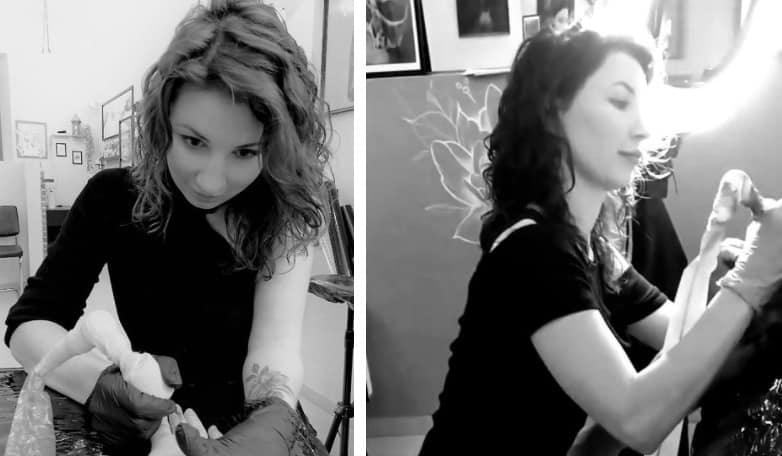
Thank you for reading my article, I hope that you have found it helpful. If you would have trouble finding ideas for your tattoo, wonder what is meaning of design that you have found or what to buy for aftercare, to make sure that your tattoo will be healing quickly and easily, here are some of my favorite products in one place, hope that this will also help.
Design and tattoo ideas
For some ideas you can have a look at those 3 books with hundreds of designs that I use with my clients, they are available on Amazon for Kindle or in classic, paper version (links below):
- Great Book of Tattoo Designs, Revised Edition: More than 500 Body Art Designs (Fox Chapel Publishing) Fantasy, Celtic, Floral, Wildlife, and Symbol Designs for the Skin by Lora Irish
- The Big Book of Small Tattoos – Vol.1: 400 small original tattoos for women and men by Roberto Gemori
- Tiny Tattoos: Over 1,000 Small Inspirational Artworks by Rebecca Vincent.
Tattoo meaning
If you would like to read more about the meaning of different tattoo styles and designs before you will decide what you would like to have, I can recommend a book that was really useful for me when I was starting my tattoo adventure – it’s “Conscious Ink: The Hidden Meaning of Tattoos” by Lisa Barretta (through the link you can find it on Amazon for around $10).
Tattoo aftercare
The skin at the tattoo site often dries out. To prevent it and speed up healing for my clients, I usually recommend one of those tattoo aftercare balms (you can find them on Amazon):
References
- 1https://www.reddit.com/r/tattoos/comments/283oxz/how_often_do_i_wash_my_new_tattoo/
- https://sorrymomshop.com/blogs/aftercare/how-often-should-you-wash-new-tattoo
- https://www.businessinsider.com/bed-how-often-should-wash-sheets-dust-mites-fungi-bacteria-2019-5?r=US&IR=T
- https://www.youtube.com/watch?v=B3zC6DNr0IA&ab_channel=Saniderm
- https://www.youtube.com/watch?v=lpPTXZ5aVTU&ab_channel=JustINKD
- https://www.quora.com/What-happens-if-you-leave-your-tattoo-wrapped-for-too-long
- https://www.quora.com/Is-it-Normal-for-my-tattoo-artist-to-tell-me-to-keep-the-bandage-for-3-days
- https://www.quora.com/How-long-should-a-new-tattoo-be-covered-with-a-bandage
- https://www.quora.com/How-long-does-it-take-to-keep-a-tattoo-wrapped-in-cling-film
- https://www.quora.com/How-long-to-leave-tattoo-bandage-or-plastic-wrap-on-my-arm
- https://www.youtube.com/watch?v=Xg9Dv7X6ck0&ab_channel=SorryMomTattoo
- https://www.youtube.com/watch?v=Kunh2VbDzj8&ab_channel=AcidPentagramPizza

